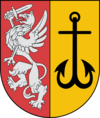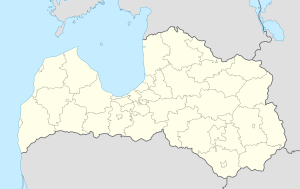Ainaži facts for kids
Quick facts for kids
Ainaži
Heinaste (Estonian)
|
|||
|---|---|---|---|
|
Town
|
|||

Ainaži lighthouse
|
|||
|
|||
| Country | |||
| Municipality | Limbaži Municipality | ||
| Area | |||
| • Total | Lua error in Module:Wd at line 1,575: attempt to index field 'wikibase' (a nil value). km2 (Formatting error: invalid input when rounding sq mi) | ||
| • Land | Lua error in Module:Wd at line 1,575: attempt to index field 'wikibase' (a nil value). km2 (Formatting error: invalid input when rounding sq mi) | ||
| • Water | Expression error: Unexpected < operator. km2 (Formatting error: invalid input when rounding sq mi) | ||
| Elevation | 0 m (0 ft) | ||
| Population
(2024)Lua error in Module:Wd at line 1575: attempt to index field 'wikibase' (a nil value).
|
|||
| • Total | 644 | ||
| Time zone | UTC+2 (EET) | ||
| • Summer (DST) | UTC+3 (EEST) | ||
| Postal code |
LV-4035
|
||
| Calling code | 640 | ||
| Climate | Dfb | ||
| Website | [1] | ||
Ainaži is a small port town in Latvia. It sits right by the Gulf of Riga, which is part of the Baltic Sea. Ainaži is located in the Limbaži Municipality in the Vidzeme region of Latvia. It's also very close to the border between Estonia and Latvia. Long ago, it was a fishing village for the Livonian people.
Contents
What's in a Name? The Meaning of Ainaži
The name Ainaži might come from the Estonian language words heina(s)-tee, which means 'hay-road'. Other ideas suggest it comes from Livonian words. These could be āina meaning 'hay' or āinagi meaning 'lonely' or 'only'. For many years, especially in older writings, the German versions of the name, like Haynasch, were used.
Ainaži Through Time: A Brief History
Ainaži was a Livonian fishing village for hundreds of years. The town was first officially mentioned in records in 1564. Over time, different groups and landowners ruled the area.
A Boom in Shipbuilding
Ainaži started to grow a lot in the 1870s. This was when it became known for building ships and sailing. In the 1800s, the Vidzeme and Courland regions had huge pine forests. Ainaži was perfectly located by the sea and near these forests. This made it an ideal spot for building ships.
In 1864, a man named Krišjānis Valdemārs helped start the first naval school in Livonia (which is now Latvia). This school taught young Estonian and Latvian farmers how to become ship captains for free. The school was open for 50 years until it was destroyed during World War I.
With the new school and the shipbuilding industry, Ainaži kept growing throughout the late 1800s. Between 1857 and 1913, more than 50 large ships were built in the town. In 1902, a working port and a railway station also opened.
By the time World War I began, Ainaži was the fourth-largest port in all of Latvia. It was the main port in the Vidzeme region, even bigger than its neighbor, Salacgrīva. The town also had its own windmills, a place to process fish, and a brick factory.
Challenges and Rebuilding
Ainaži faced big challenges during both World War I and World War II. During World War I, the town was badly damaged. The port was ruined, and all the ships were destroyed. After the war, Ainaži became part of Latvia.
The town worked hard to rebuild itself between 1918 and 1940. The sunken ships that blocked the harbor were removed. The harbor was made deeper, and the port was rebuilt in 1923. In 1930, the Ainaži lighthouse was built to guide ships.
However, Ainaži was destroyed again in World War II. The second naval academy burned down, the port was bombed, and its warehouses were emptied. Even though the port was partly rebuilt after the war, Ainaži became less important. Nearby Pärnu became a bigger port, and Ainaži even lost its fish-processing factory to Salacgrīva.
Ainaži Today
After Latvia became independent again in 1991, Ainaži continued to develop. A wind turbine was built in the town, and a customs house was set up at the Estonian border. Today, the old naval school building is now the Museum of Ainaži Naval School. This museum teaches visitors about the history of the school and the long tradition of shipbuilding along the Vidzeme coast.
Weather in Ainaži
Ainaži has a humid continental climate. This means it has warm summers and cold winters.
| Climate data for Ainaži (1991-2020 normals, extremes 1906–present) | |||||||||||||
|---|---|---|---|---|---|---|---|---|---|---|---|---|---|
| Month | Jan | Feb | Mar | Apr | May | Jun | Jul | Aug | Sep | Oct | Nov | Dec | Year |
| Record high °C (°F) | 8.1 (46.6) |
10.8 (51.4) |
18.3 (64.9) |
25.3 (77.5) |
29.8 (85.6) |
33.2 (91.8) |
33.7 (92.7) |
33.2 (91.8) |
30.0 (86.0) |
22.0 (71.6) |
15.4 (59.7) |
10.5 (50.9) |
33.7 (92.7) |
| Mean daily maximum °C (°F) | −0.4 (31.3) |
−0.7 (30.7) |
2.9 (37.2) |
9.6 (49.3) |
15.3 (59.5) |
18.9 (66.0) |
21.9 (71.4) |
21.2 (70.2) |
16.5 (61.7) |
10.1 (50.2) |
4.7 (40.5) |
1.6 (34.9) |
10.1 (50.2) |
| Daily mean °C (°F) | −2.6 (27.3) |
−3.3 (26.1) |
−0.3 (31.5) |
5.2 (41.4) |
10.6 (51.1) |
14.8 (58.6) |
17.7 (63.9) |
17.0 (62.6) |
12.6 (54.7) |
7.1 (44.8) |
2.6 (36.7) |
−0.4 (31.3) |
6.7 (44.2) |
| Mean daily minimum °C (°F) | −5.4 (22.3) |
−6.5 (20.3) |
−4.0 (24.8) |
0.6 (33.1) |
4.9 (40.8) |
9.6 (49.3) |
12.5 (54.5) |
11.9 (53.4) |
8.2 (46.8) |
3.8 (38.8) |
0.0 (32.0) |
−2.9 (26.8) |
2.7 (36.9) |
| Record low °C (°F) | −35.7 (−32.3) |
−35.3 (−31.5) |
−34.4 (−29.9) |
−18.8 (−1.8) |
−7.5 (18.5) |
−1.3 (29.7) |
2.0 (35.6) |
0.2 (32.4) |
−4.8 (23.4) |
−13.8 (7.2) |
−18.7 (−1.7) |
−37.1 (−34.8) |
−37.1 (−34.8) |
| Average precipitation mm (inches) | 45.9 (1.81) |
34.3 (1.35) |
32.0 (1.26) |
32.1 (1.26) |
41.7 (1.64) |
64.9 (2.56) |
54.0 (2.13) |
79.5 (3.13) |
58.6 (2.31) |
79.3 (3.12) |
62.5 (2.46) |
53.7 (2.11) |
638.5 (25.14) |
| Average precipitation days (≥ 1.0 mm) | 10 | 8 | 8 | 7 | 7 | 9 | 7 | 10 | 9 | 12 | 11 | 11 | 109 |
| Average relative humidity (%) | 88.0 | 86.4 | 81.5 | 75.3 | 73.9 | 77.9 | 78.9 | 79.0 | 81.8 | 84.5 | 87.2 | 87.8 | 81.9 |
| Source 1: LVĢMC | |||||||||||||
| Source 2: NOAA (humidity and precipitation days 1991-2020) | |||||||||||||
| Coastal temperature data for Ainaži | |||||||||||||
|---|---|---|---|---|---|---|---|---|---|---|---|---|---|
| Month | Jan | Feb | Mar | Apr | May | Jun | Jul | Aug | Sep | Oct | Nov | Dec | Year |
| Average sea temperature °C (°F) | 1.7 (35.06) |
0.3 (32.54) |
0.0 (32.00) |
2.1 (35.78) |
8.7 (47.66) |
14.7 (58.46) |
19.4 (66.92) |
18.6 (65.48) |
15.1 (59.18) |
11.1 (51.98) |
7.6 (45.68) |
4.1 (39.38) |
8.6 (47.51) |
| Source 1: Seatemperature.net | |||||||||||||
How Ainaži Makes Money: Economy
The most important ways Ainaži makes money are through forestry (working with forests), woodworking (making things from wood), and trade. Because Ainaži is located right on the border between Latvia and Estonia, and on the A1 road (Latvia) (which is part of the international Via Baltica highway), it's also a good place for transportation and transit businesses.
Who Lives in Ainaži: Demographics
In 2005, about 1,794 people lived in Ainaži and the area around it. This made it the smallest official town in the Vidzeme region. Most of the people living there were Latvians (92%). There were also Russians (3%), Estonians (2%), and other groups (4%). The population has decreased over the years.
| Historical population | |||||||||||||||||||||||||||||||
|---|---|---|---|---|---|---|---|---|---|---|---|---|---|---|---|---|---|---|---|---|---|---|---|---|---|---|---|---|---|---|---|
|
|
||||||||||||||||||||||||||||||
| Source: Latvian Geospatial Information Agency | |||||||||||||||||||||||||||||||
Gallery
Sister Cities
Ainaži has special friendly connections with these other towns:
See also
 In Spanish: Ainaži para niños
In Spanish: Ainaži para niños













